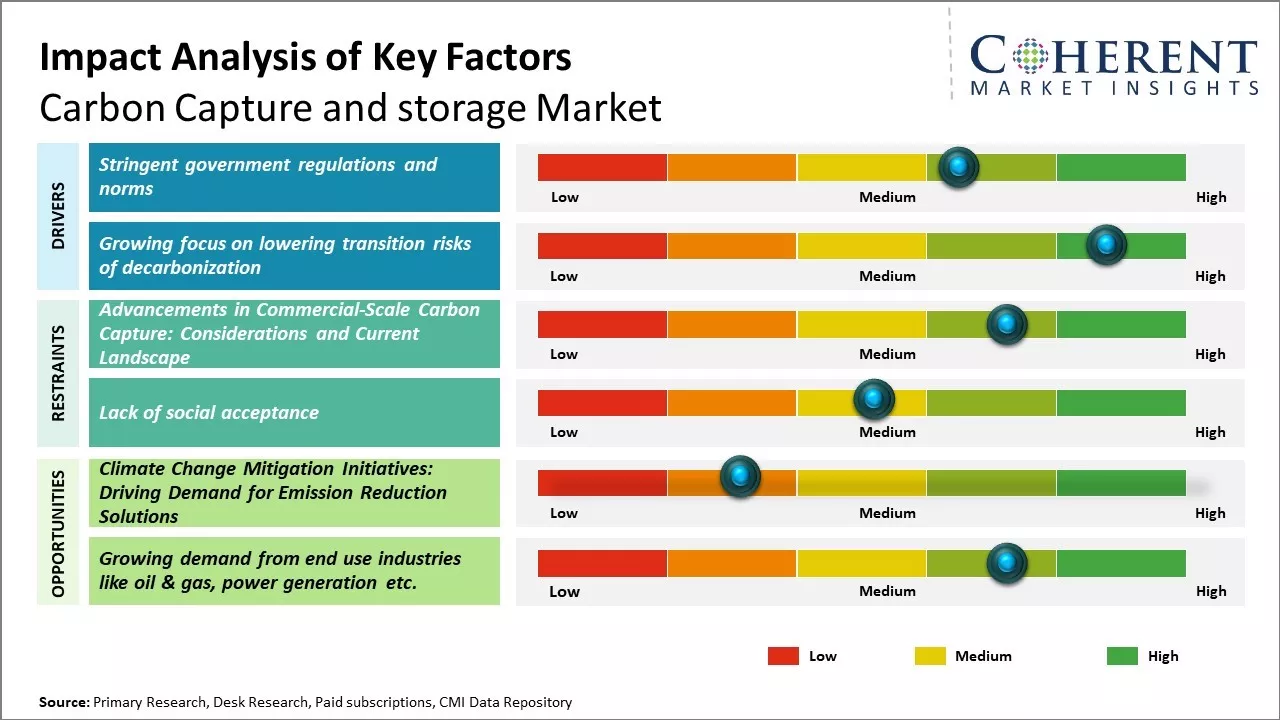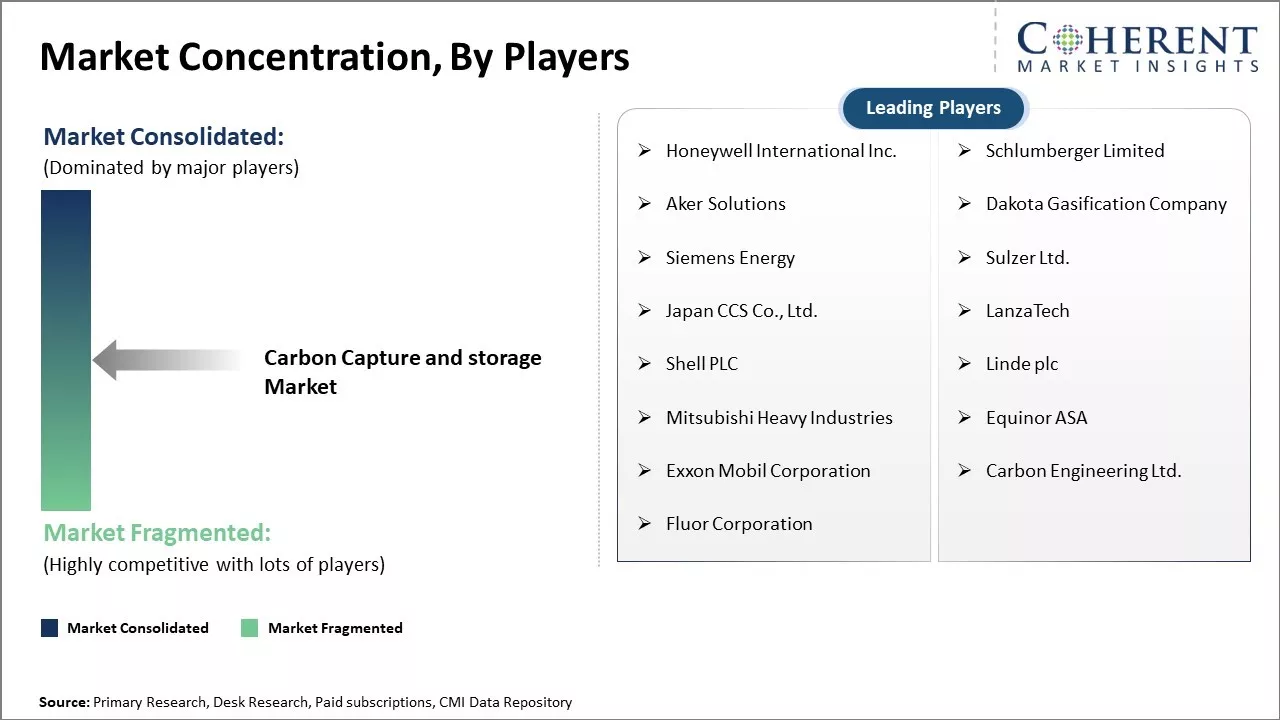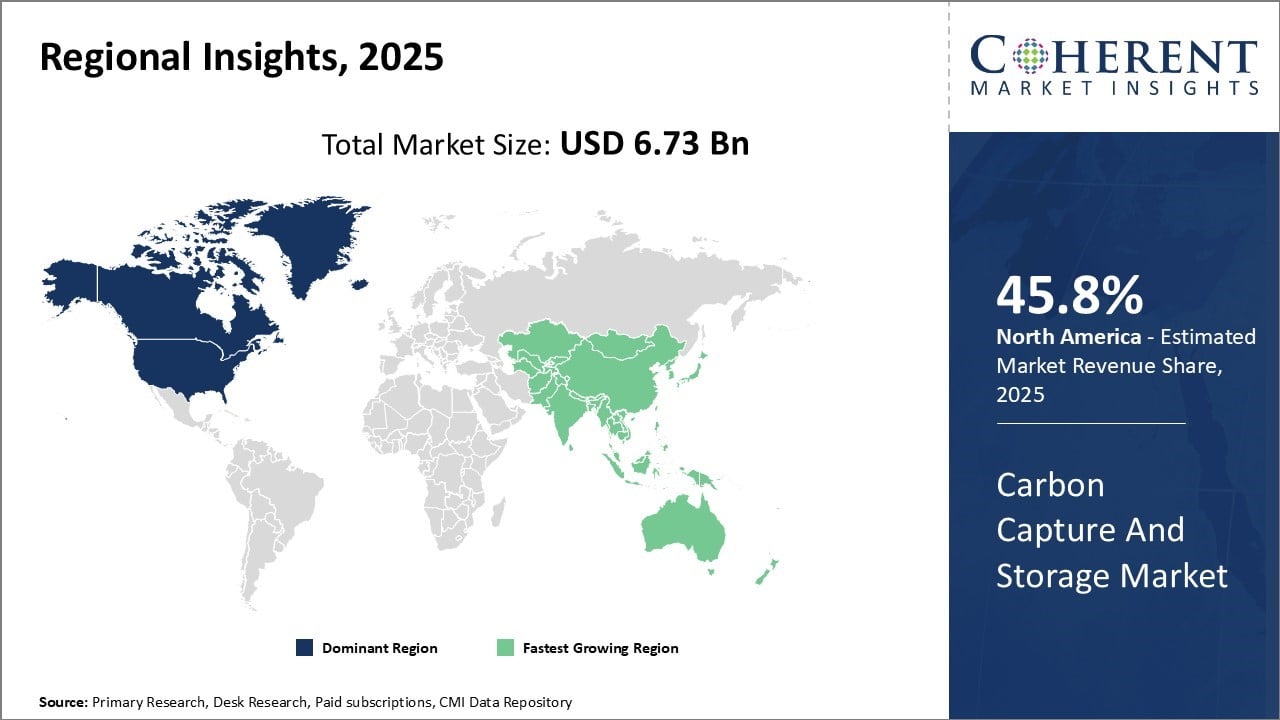The carbon capture and storage market size is estimated to be valued at USD 6.73 Bn in 2025 and is expected to reach USD 15.46 Bn by 2032, growing at a compound annual growth rate (CAGR) of 12.6% from 2025 to 2032.

To learn more about this report, Download Free Sample
The carbon capture and storage market demand is expected to grow significantly over the forecast period. This can be primarily attributed to the stringent government regulations regarding emission control and carbon reduction targets globally. The increasing utilization of CCS technology in applications such as enhanced oil recovery is driving growth aligned with the carbon capture and storage technology roadmap.
Moreover, rising environmental concerns resulting from high carbon emissions from industries, such as cement, mining, and power generation, is prompting market players to adopt carbon capture technologies and offer solutions. However, high capital investment associated with carbon capture and lack of overall infrastructure is a major restraint challenging the market growth. But increased government investments and subsidies in key markets are expected to counter this effect.
|
Event |
Description and Impact |
|
U.S. Inflation Reduction Act and Global Climate Policy Alignment |
|
|
Direct Air Capture Technology Breakthroughs and Scaling |
|
|
Europe's REPowerEU and Industrial Decarbonization Strategy |
|
Uncover macros and micros vetted on 75+ parameters: Get instant access to report
The carbon capture and storage market forecast reflects a tiered pricing structure influenced by technology type, source CO₂ concentration, and regional infrastructure. Capture costs for high-purity industrial CO₂ streams, such as natural gas processing, ranged from approximately USD15–25 per ton through early 2025. For instance, in Q1 2024, capture costs were around USD20/ton in North America, USD18/ton in Europe, and USD22/ton in Asia Pacific.
In Q2 2024, costs for dilute CO₂ streams from power and cement plants surged to USD60–90/ton due to higher energy demands, while costs for industrial sources remained relatively stable. By March 2025, overall capture and storage pricing in commercial projects—including enhanced oil recovery and saline aquifer storage—moderated to approximately USD45/ton in North America, USD50/ton in Europe, and USD40/ton in Asia Pacific.
Direct air capture (DAC) technologies command a premium, with prices typically ranging from USD 150–600 per ton, depending on scale and technology maturity. Large-scale DAC projects in the USA and Europe have projected costs toward the lower end of this range, driven by technological improvements and economies of scale.
AI and automation are subtly transforming the carbon capture and storage market by enhancing precision, operational efficiency, and system reliability—mirroring smart innovations seen across other sectors. Advanced capture technologies now incorporate IoT sensors, real-time monitoring, and predictive analytics to optimize key process parameters such as temperature, pressure, and solvent regeneration cycles—significantly reducing energy consumption and operational costs.
In commercial CCS facilities, machine learning models predict capture efficiency and solvent degradation rates based on process data, enabling automated adjustments that maximize CO₂ recovery while minimizing downtime. Furthermore, AI-driven predictive maintenance flags potential equipment failures early, helping operators fine-tune performance in real time and reduce unplanned outages. These technological advancements are driving improved capture rates, cost-effectiveness, and scalability of CCS projects worldwide.

To learn more about this report, Download Free Sample
Many governments across the globe have mandated strict regulations and norms to curb carbon emissions and combat climate change. Carbon capture and storage (CCS) is being strongly promoted as an important technology by international organizations to reduce greenhouse gas emissions from large stationary sources like fossil fuel-based power plants and industrial facilities. Several countries have formulated policies that stipulate carbon pricing and cap the number of emissions that can be released by heavy polluting sectors.
Non-compliance would attract hefty financial penalties. This is compelling private companies and power generators to explore CCS as a viable option to curtail their carbon footprint in a cost-effective manner. Regulations in Europe, Aisa Pacific, North America, and other regions require emission sources exceeding certain thresholds to deploy carbon capture. Government subsidies and tax incentives are incentivizing the adoption of CCS projects.
Strict emission norms being drafted for the future would increase the need for end-of-pipe carbon abatement technologies like CCS. The policy push is expected to be a key driver boosting demand for CCS systems from energy intensive industries and utilities over the coming years.
More people are focusing on balancing carbon capture and storage vs renewable energy as part of the broader shift from fossil fuels to cleaner alternatives. Rapid decarbonization runs the risk of leaving certain assets stranded and impacting energy security if not planned and executed carefully.
CCS provides an important bridging technology that can help lower such transition risks by providing a means to decarbonize existing fossil fuel-based infrastructure in a graduated, cost-effective manner. CCS allows the continued utilization of resources invested in coal and gas-fired power plants and refineries by facilitating their operation in a carbon neutral way. This buys valuable time to scale up renewable sources and implement disruptive emission reduction strategies while maintaining grid stability.
CCS also provides solutions for industries like aviation, shipping, and heavy manufacturing, which find it tough to reduce emissions. They heavily depend on liquid fuels and encounter difficulties in quickly switching to low-carbon options.
The technologies needed for viable commercial-scale carbon capture are still quite expensive compared to its alternatives. Public acceptance of underground carbon storage also remains uncertain. Regulatory frameworks for long-term liability and monitoring of stored carbon are still being developed in many jurisdictions. Significant transportation infrastructure would be required to transport captured carbon from emission sources to suitable storage sites. The market also lacks financial incentives for first movers, as the social cost of carbon is not yet reflected in energy prices.
Government investments and regulations around climate change mitigation are driving the demand for options to reduce hard-to-abate industrial emissions. Developing expertise in carbon capture and storage technologies and services presents an opportunity to export knowledge and projects to other regions.
In terms of technology, post-combustion contributes the highest share of the market owing 40.2% in 2025 to its ability to efficiently reduce carbon emissions from existing fossil fuel power plants and industrial facilities. Post-combustion captures carbon dioxide after the combustion of fossil fuels such as coal, natural gas, or oil. This allows the existing fossil fuel power generation infrastructure to continue operating while significantly reducing their carbon footprint. The captured CO2 can then be stored underground or utilized for enhanced oil recovery.
Post-combustion is considered the most economically viable option for retrofitting carbon capture technologies to existing power plants and industrial facilities without requiring major infrastructure changes or process modifications. Its flexibility makes it well suited for a variety of applications ranging from natural gas combined cycle plants to cement factories. Advanced amine solvents offer higher absorption rates and lower regeneration energy requirements compared to first generation technologies, improving the business case for implementation.
Government policies incentivizing carbon capture deployment and utilization of captured CO2 for enhanced oil recovery further boost the adoption of post-combustion systems. These factors strengthen post-combustion's leading role in the carbon capture and storage market outlook by enabling cost-effective emission reductions from existing fossil fuel assets.
In terms of application, oil and gas contributes the highest share of 27.8% for year 2025 of the carbon capture market due to the rising need to curb emissions from production activities. Carbon capture technologies play a vital role in reducing the carbon footprint of oil and gas operations which contribute over 20% of global greenhouse gas emissions.
It allows operator to meet increasingly stringent emission regulations while continuing production from both conventional and unconventional reserves. Captured CO2 can also be utilized for enhanced oil recovery which improves production rates from mature oil fields. This dual benefit of lowering emissions and boosting reserves drives considerable investment in carbon capture projects linked to oil and gas facilities. Depleted oil and gas reservoirs provide suitable geological storage locations for captured CO2.
Meanwhile, natural gas processing emits high purity CO2 streams which are relatively easy to capture. These synergies consolidate the oil and gas segment's lead in the carbon capture industry. As global energy demand increases production from sources like oil sands with higher emission profiles, deployment of carbon management technologies in this sector will continue growing rapidly.
In terms of service, capture contributes the highest share of 34.1% for 2025 of the carbon capture market given the high commercial value attributed to captured carbon dioxide. While transportation and storage are essential components, capture technology and related services generate the most revenue as they guarantee the supply of the high value CO2 commodity.
Advanced amine systems and other emerging post-combustion capture technologies offer efficiency gains that slash the cost of separating and compressing CO2. Their improved performance relies on sophisticated process engineering, specialized solvent formulations, and proprietary equipment customized for each project. This reliance on innovative technologies and expertise drives the strong demand for carbon capture system design, installation, commissioning, and operational services.
Carbon dioxide also commands a market price when utilized for enhanced oil recovery or other commercial uses like urea production. Its value as a product or tradable emission offset incentive increases capital spending on capture facilities and performance optimization services. Carbon capture projects are also intricate engineering feats requiring extensive feasibility planning, risk assessment, and verification services. These factors collectively reinforce capture services as the highest revenue segment in the evolving carbon management industry.

To learn more about this report, Download Free Sample
North America currently dominates the global carbon capture and storage industry, holding a 45.8% share of the carbon capture and storage market value in 2025. This region has a strong presence of leading CCS technology providers and early movers in the domain. Countries like the U.S. and Canada have implemented supportive policies and regulations to promote CCS projects. Various pilot projects capturing emissions from natural gas processing and power plants have allowed operators to gain valuable operational experience in the region.
The U.S. in particular has emerged as the global leader with around 15 large-scale CCS facilities capable of capturing over 25 million tons of CO2 annually. Several oilfields located near emission sources help facilitate CO2 injection and storage. Recognizing CCS as a key element in its decarbonization strategy, the U.S. government has allocated attractive tax credits for new CCS projects. Leading energy companies are investing heavily to reduce the cost of emission separation and compression technologies.
Another growing region is the Asia Pacific. Countries like China, Japan, and South Korea are aggressively pursuing CCS to meet stringent long-term climate goals. This region, responsible for over 50.5% of global CO₂ emissions, highlights key opportunities aligned with carbon capture and storage market trends for growth. China especially has shown determination with pilot projects capturing CO2 from coal and gas facilities.
A positive regulatory framework and strong state funding augur well for wide commercial deployment in the coming decade. Energy companies from the region are now jointly developing advanced technologies suitable for their large emitting industries. The availability of suitable geological storage options further boosts the region’s attractiveness for CCS infrastructure development.
| Report Coverage | Details | ||
|---|---|---|---|
| Base Year: | 2024 | Market Size in 2025: | USD 6.73 Bn |
| Historical Data for: | 2020 To 2024 | Forecast Period: | 2025 To 2032 |
| Forecast Period 2025 to 2032 CAGR: | 12.6% | 2032 Value Projection: | USD 15.46 Bn |
| Geographies covered: |
|
||
| Segments covered: |
|
||
| Companies covered: |
Honeywell International Inc., Schlumberger Limited, Aker Solutions, Dakota Gasification Company, Siemens Energy, Sulzer Ltd., Japan CCS Co., Ltd., LanzaTech, Shell PLC, Linde plc, Mitsubishi Heavy Industries, Equinor ASA, Exxon Mobil Corporation, Carbon Engineering Ltd., and Fluor Corporation |
||
| Growth Drivers: |
|
||
| Restraints & Challenges: |
|
||
Uncover macros and micros vetted on 75+ parameters: Get instant access to report
Share
Share
About Author
Ankur Rai is a Research Consultant with over 5 years of experience in handling consulting and syndicated reports across diverse sectors. He manages consulting and market research projects centered on go-to-market strategy, opportunity analysis, competitive landscape, and market size estimation and forecasting. He also advises clients on identifying and targeting absolute opportunities to penetrate untapped markets.
Missing comfort of reading report in your local language? Find your preferred language :
Transform your Strategy with Exclusive Trending Reports :
Frequently Asked Questions
Joining thousands of companies around the world committed to making the Excellent Business Solutions.
View All Our Clients